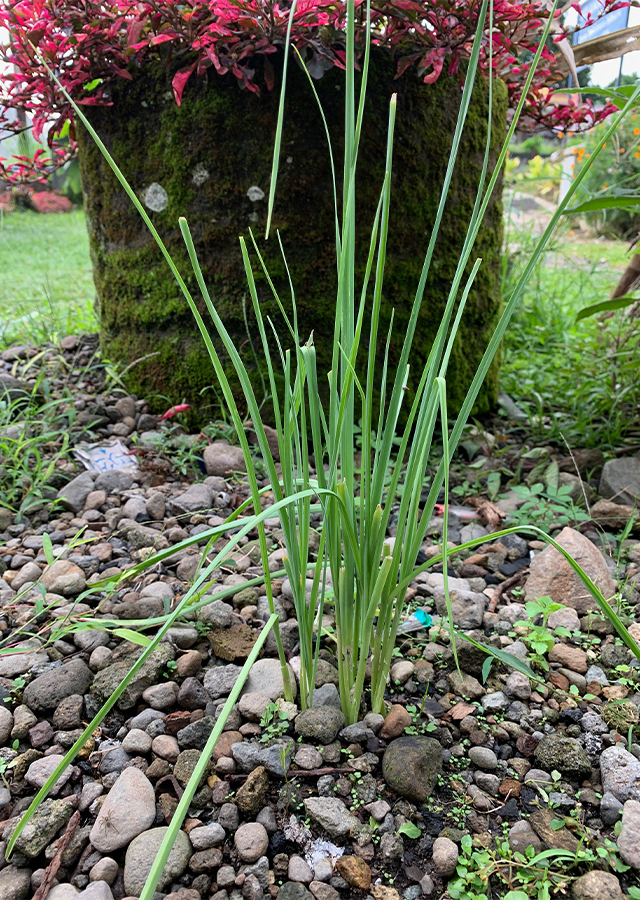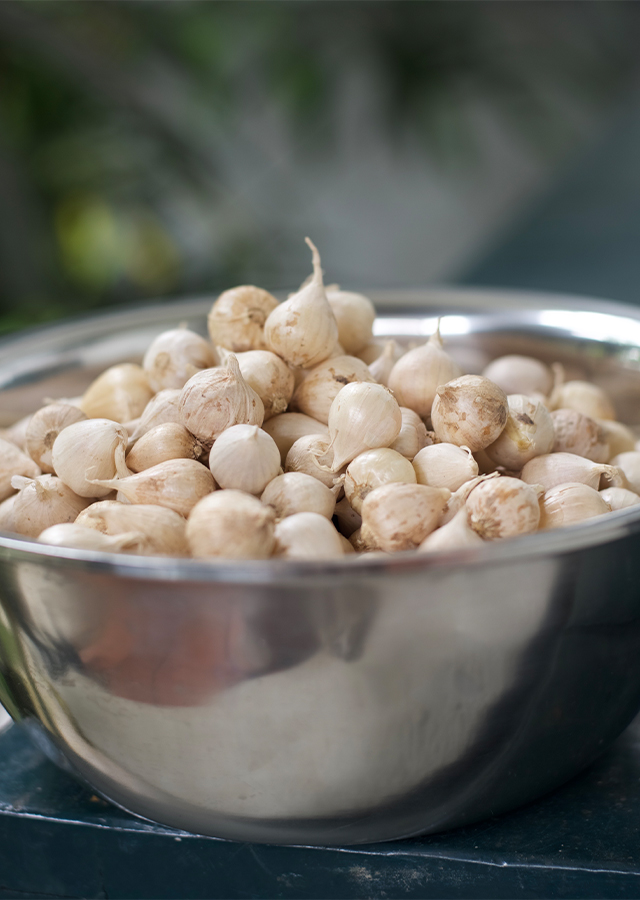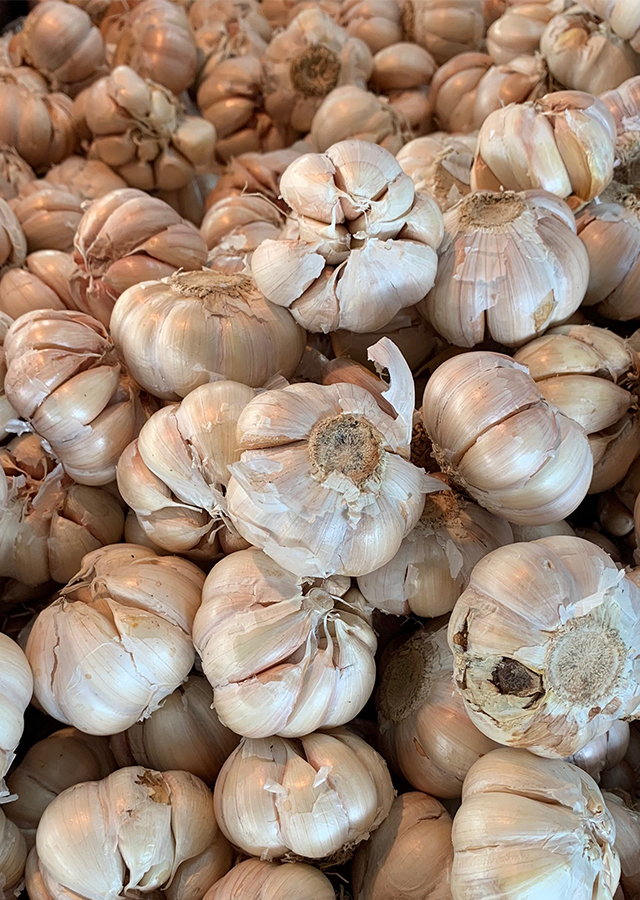Garlic
Allium sativum L.
Amaryllidaceae
Location in our garden
Vegetable



Synonym
Allium arenarium Sadler ex Rchb.
Allium controversum Schrad. ex Willd.
Allium longicuspis Regel
Habitus
Herbaceous. A bulbous perennial growing to 30 cm –1 m, herbaceous with pale pink or green white flowers. This plant grow in clumps
Part Used
Leaves
Tuber
Growing Requirements
Full Sunshine
Habitat
Terrestrial
Overview
Originally from Central Asia, garlic is now grown world wide. It has been postulated to be transported from Central Asia to the Mediterranean and other areas of cultivation. Garlic has been domesticated since antiquity and has been mentioned in ancient Egyptian, Babylonian, Greek, Indian and Chinese historical manuscripts. Garlic has a very long history of use as food and medicine. The plant enter Indonesia, it is not known with certainty,allegedly brought by traders from India, China,Arabic and Portuguese in the 19th century.
Vernacular Names
Ail (Arabic), Da suan (Chinese), Knofl ook (Ducth), Ail ordinaire (French), Nohoru (India), Gaarikku (Japanese), Kallik (Korean), Chesnok (Russian).
Agroecology
It is grown globally in both warm temperate and subtropical areas, and many cultivars have been developed to suit different climates. Succeeds in most soils, but prefers a sunny position in a moist light well-drained soil. It grows best in areas where annual day time temperatures are within the range of 18-30 °C and annual rainfall in the range of 750-1,600 mm. Prefers a pH between 6-6.6, but dislikes very acid soils. The bulb is liable to rot if grown in a wet soil. Garlic generally grows in the highland, but certain varieties are able to grow in lowland. Clay textured soil sandy or dusty loam with a neutral pH be a good growth medium.
Morphology
- Roots - adventitious. Root which grows on the main stem is rudimentary, serves as a suction tool food. From the base stems grow roots in the form of small fibers that many with a length of less than 10 cm. Garlic forms bulbs White colour. A tuber consists of 8–20 garlic cloves. Between one clove to another separated by a thin skin and tough, and form a one strong and tight unit. Inside the clove There are embryos that can grow through clove shoots become new shoots, that functions of clove as a protector and storehouse of food supplies
- Stems - real stem is much reduced to a basal disc at the base of the bulb. Pseudostem is formed by the sheathing bases of the leaves.
- Leaves - broadly linear to linear-lanceolate, shorter than scape, to 2.5 cm wide, apex acuminate, glabrous with smooth margin. The scape is 50–100 cm, erect, terete.
- Flowers - sub-campanulate, tepals ovate- lanceolate in two whorls, and up to 4 mm long, greenish purple, stamens in two whorls and pistil globose, tricarpellate, style not exserted. Flowers are compound interest rounded arranged; forms an umbrella inflorescence with a diameter of 4–9 cm. Flower jewelry in the form of a flower tent with 6 ovate in the shape of an egg. Stamen totaling 6, with a filament length of 4-5 mm, resting on floral jewelry base. Superior ovary, arranged over 3 rooms.
- Fruits - a capsule (splits along two or more seams, apical teeth or pores when dry, to release two or more seeds). Small fruit capsule loculicidal
- Seeds - small seed, very difficult to form seeds, because flowers abortion or sterility.
Cultivation
- Propagated by dividing the bulb.
- Plant out the cloves with their noses just below the soil surface.
- The plant takes 9 -180 days from planting to harvesting. Yields within the range of 5 -10 t/ha.
- In general, garlic bulbs cannot be used directly as planting material because of their relatively long dormancy period, which is about 4 months after harvest. Temperature treatment can be carried out to accelerate the dormancy breaking process.The best vernalization time to increase the growth and production of onions whiteness was obtained at 4 weeks and 8 weeks.
Chemical Constituents
Essential oils, scordinin, salvitine, organosulfur compounds (diallyl thiosulfonate (allicin), diallyl sulfide (DAS), diallyl disulfide (DADS), diallyl trisulfide (DATS), E/Z-ajoene, S-allyl-cysteine (SAC), S-allyl-cysteine sulfoxide (alliin)), saponins, phenolic compounds.
Traditional Medicinal Uses
- It is used in a wide range of ailments, particularly ailments such as ringworm, Candida and vaginitis where its fungicidal, antiseptic, tonic and parasiticidal properties have proved of benefit.
- Daily use of garlic in the diet has been shown to have a very beneficial effect on the body, especially the blood system and the heart.
- The bulb is anthelmintic, antiasthmatic, anticholesterolemic, antiseptic, antispasmodic, cholagogue, diaphoretic, diuretic, expectorant, febrifuge, stimulant, stings, stomachic, vasodilator.
- Recent research has also indicated that garlic reduces glucose metabolism in diabetics, and slows the development of arteriosclerosis.
- Juice of bulb with common salt is applied to bruises and sprains; also used for neuralgia and earache.
- Decoction of leaves and bulbs is used for fever and as hypotensive, carminative, expectorant, and antihelmintic.
- Juice from freshly crushed garlic is used for colds, cough, sore throat, hoarseness, asthma and bronchitis.
- Garlic tea (with lemon and honey) is used to treat flu and common cold and to promote sweating to lower fever.
- Raw garlic or garlic tincture is widely taken to strengthen the immune system.
- In Mexico, fresh bulb is eaten as a preventive for tuberculosis.
Part Used
Reference Sources
- Chevallier, A.( 2016). Encyclopedia of Herbal Medicine. DK Publishing, New York. Third edition page 59.
- Fern, Ken. (2019). Useful Tropical Plants Database. Garlic. Allium sativum. http://tropical.theferns.info/viewtropical.php?id=Allium+sativum. 22-01-2021.
- Go Botany. (2021). Allium sativum L. https://gobotany.nativeplanttrust.org/species/allium/sativum/. 22-01-2021.
- Lim, T.K. (2016). Edible Medicinal and Non-Medicinal Plants. New York. Springer, v.9 p.210.
- Hernawan UE, Setyawan AD. 2003. REVIEW: Organosulphure compound of garlic (Allium sativum L.) and its biological activities Biofarmasi 1 (2): 65-76, DOI: 10.13057/biofar/f010205 22 Nov 2021.
- Siswadi E, Putri SU, Firgiyanto R, Putri CF. 2019. Increased of Growth and Production of Garlic (Allium sativum L.) through Vernalization and BAP (Benzyl Amino Purine) application. AGROVIGOR 12 (2): 53 – 58. DOI: 10.21107/agrovigor.v12i2.5419. 22 Nov 2021.

